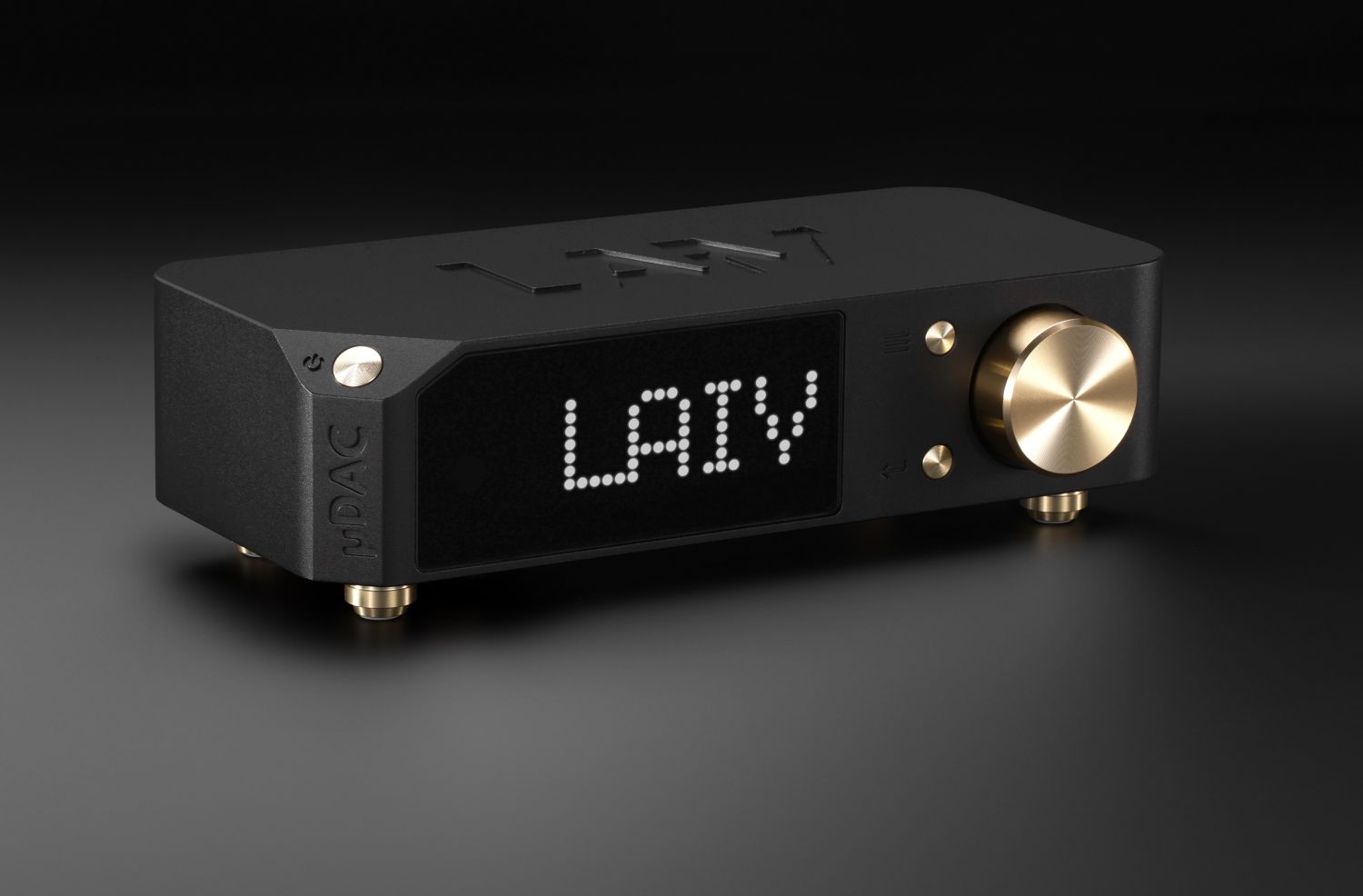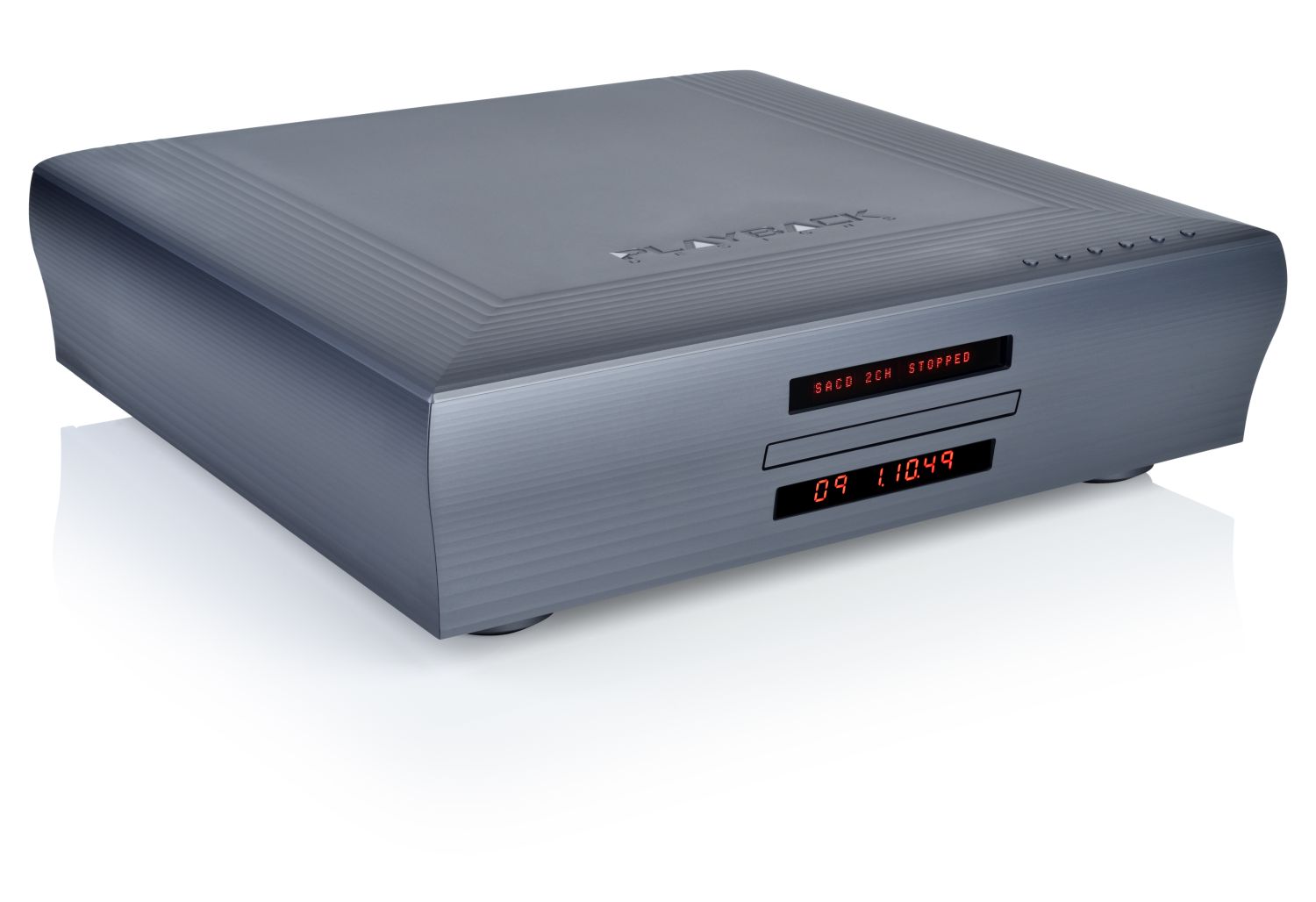Weiss DAC502 DSP DAC and Network Renderer
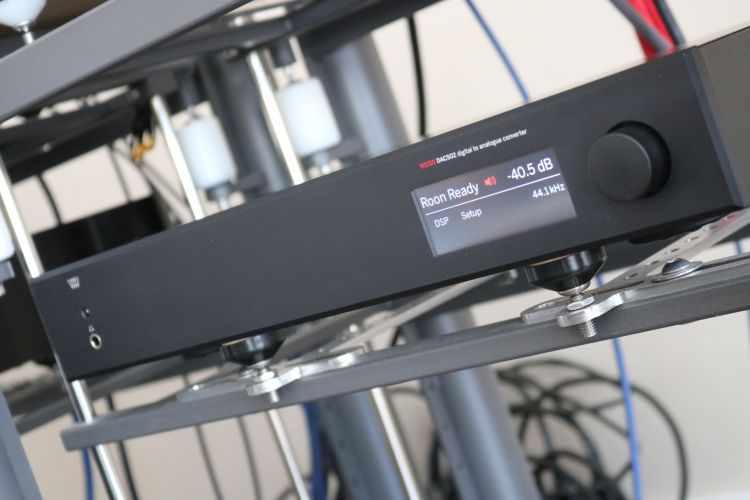
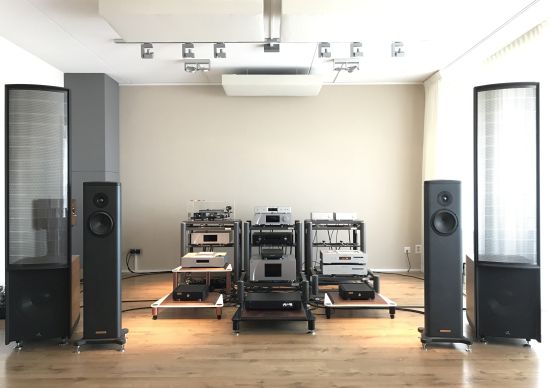
Listening – USB
Switching from RoonReady via direct Ethernet to USB via a Pink Faun USB cable, the sound is noticeably smoother and more relaxed, precisely as per this cable’s character, but also less vital and less propulsive. So far, this is in line with my overall preference for the pure, unrestrained and free-flowing yet crispy and articulate sound that can be achieved with RAAT via a network connection.
But after swapping to the Final Touch Audio Callisto USB cable, I’m not so sure anymore of the ranking order. Although I retain a mild preference for the network input, with the Callisto, USB now sounds very close to RoonReady. Indeed, when listening closely, you can tell what’s what but it is certainly not a very obvious difference.
Listening – S/PDIF
As always, the Jay’s Audio CDT-2 MkII provides a unique perspective. Full and smooth yet upbeat, dynamic and very involving, it is the ideal source for when you want to add some more romance to the sound. The Weiss may be positioned on the clean side of neutral but as the Pink Faun cable already indicated, the CD-T2 MkII, connected via coaxial S/PDIF, further illustrates that the DAC can truly swing both ways.
But how am I to properly assess the DAC502’s S/PDIF inputs using a CD player with such a deviating sonic style? This called for a revisit of the Aqua La Diva, which is the tightest, liveliest and most neutral CD transport that I have heard so far.
Marco Oudheusden of Hexagon Audio was so kind as to bring it over once again. The La Diva quickly reconfirmed its status as a reference CD transport by delivering what it always does: high precision and neutrality combined with lots of refinement. From past experience, I know that this player’s outputs sound pretty much identical to one another and thus the differences, if any, would be down mainly to the cables and the DAC’s receiver implementation.
The most precise sound is achieved via AES/EBU but the DAC502’s S/PDIF coax connection is pretty close. Both inputs sound great and, on the surface, both renditions pretty similar to the USB and RoonReady sound. When really getting down to it, though, I can divide it up into two camps: the two music server connections on the one side and the traditional connections on the other. The La Diva remains a touch purer and more direct while retaining more flair than the Antipodes CX+EX combo but the difference is admittedly not night and day. Considering that the music server is certainly not entirely exempt from an audible influence itself, I’d say that the results speak very highly of the consistency of the Weiss’ inputs!
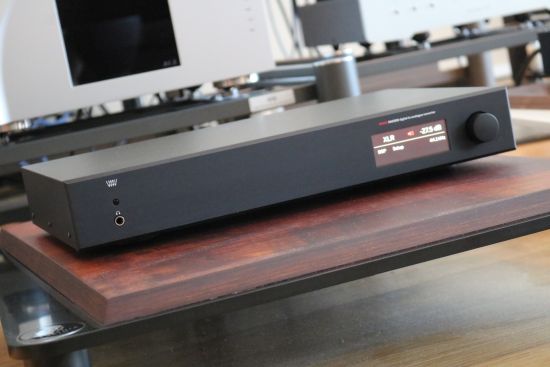
Placement
The DAC502 unfolds its strengths pretty much regardless of what surface I placed it on. It sounds great on the Artesania Modular Rack but it doesn’t really need this rack’s added sonority. The best balance was obtained with the DAC on the Artesania Exoteryc rack which helps extract the music in a super-transparent manner while adding a touch of fluidity and refinement.
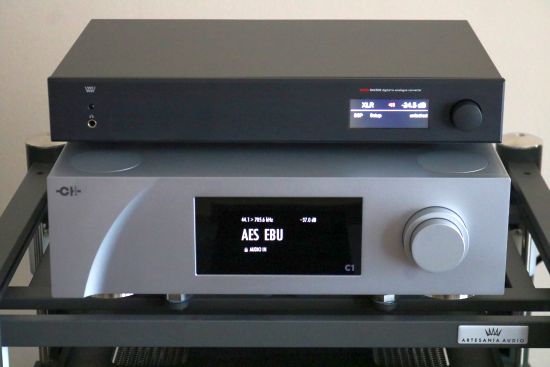
Comparisons
Another DAC that I am currently reviewing is the APL DSD-AR. Conceptually very different from the Weiss, these DACs are sonically also different, even if they share certain similarities. While both DACs are clean, agile, transparent and utterly neutral and both are very highly resolving and well-focused, the Weiss has a more no-nonsense, earthy and grounded presentation while the APL is more free-flowing and ethereal.
Adding the Martin Logan ESL15A speakers to the mix and throwing in a DAC reference of the “arm and leg”-category, the Weiss proves to be in some ways closer to the CH Precision C1 than to the APL. While not as full-blooded and organic, the Weiss has a similar kind of solidity and transient behavior. At the -10dB output level, the Weiss is a tiny bit more relaxed than the C1 but when set at the 0dB output level setting it comes right alongside in that respect. Especially now that I am comparing it directly with the C1 and in combination with the, relative to the Magicos, slightly forgiving Logans, I find that the DAC’s treble is actually very well-behaved. It is subtle, refined and actually pretty much on the level of the C1, which is to say, outstanding. What I do note is that its overall delivery, in this context, is cooler and soberer than that of the C1 and less spacious. Just why the C1 manages to sound so accurate and transparent while simultaneously having a richer tonality and more “Schwung”, I don’t know. I guess that its breathtaking price tag must account for something besides nice cosmetics.
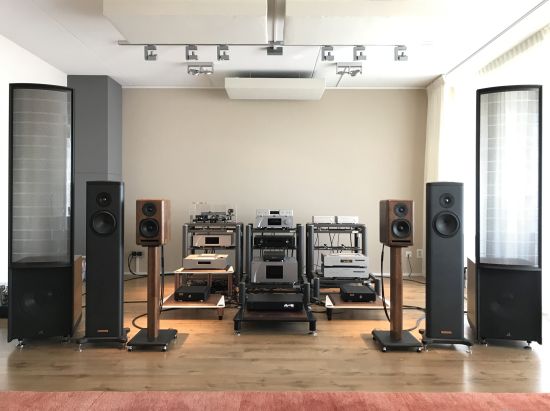
Even in this overly cramped setup, the tiny Xavians sounded full-bodied and super-spacious with the DAC502 as the front end
Finally, I also used the DAC502 as the front end during the review of the atm-Audio EPM-700 hybrid Class A/Class D power amplifiers, and let me tell you, this is where it landed exactly in the sweet spot. Paired with a set of Xavian La Perla loudspeakers and Driade Flow 405 speaker cable, this combination made music in a super-involving manner!
I chose the DAC502 for this review because the atm-Audio amps sounded a little too rounded during an earlier assessment with the Magico’s. Thus, I connected the easy to drive Xavians and grabbed the Weiss as the most “ruthlessly” revealing source. But what do you know? The Weiss’s neutrality and excellent impulse behavior were exactly what the atm-Audio amps needed to spark life into the proceedings while the Xavians did their known trick of sounding revealing yet infectiously dynamic and propulsive, along with a richly saturated tonality. Was this combination revealing? You bet! Was it ruthless? Not at all. Rather, there was some mighty fine music-making going on here.
As with the Magicos, I found that this combination sounded best with the DAC502’s output level set to -10dB while the 0dB setting at times made the treble a little bit too blunt. Surely, that is a “feature” of the Xavians’ tweeters but it’s good to be able to tweak for this. Interestingly, the soundstage was now as large as the room with sounds coming from seemingly everywhere except straight from the speakers. Actually, a friend who was listening in had to do a double-check to confirm that it was really the Xavians producing this room-filling sound.
This truly was a rare case of amazing lushness combined with boundless dynamics and great PRaT. Surely, the EPM-700’s Nutube triode input stage has something to do with the now abundant soundstaging. But, importantly, this result proves that the DAC502 is not an inhibiting factor in any respect. This is the great thing about neutrality – there is room in either direction!
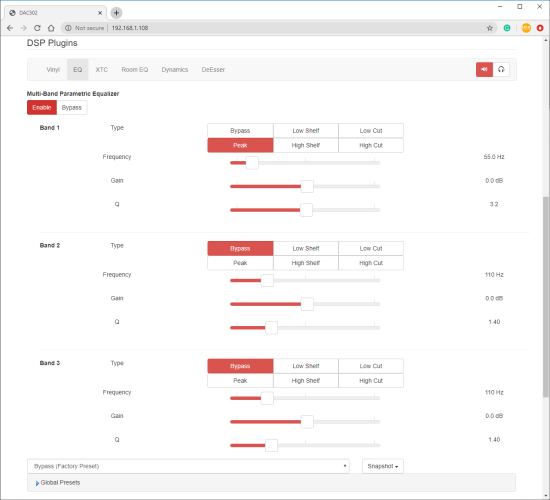
DSP Plugins
At the time of reviewing, the DSP502 offered 6 DSP plugins. The manual indicates that more are in development and will be added later. All the settings respond in real-time, making adjustments easy and intuitive.
Vinyl Emulation
I don’t quite know what to make of the Vinyl Emulation. As a vinyl enthusiast, I don’t hear anything with this plugin that reminds me of analog, well, not in a positive manner, that is. What the filter seems to do is emulating the downsides of Vinyl by slightly compressing the soundstaging and dynamics. There is a slider to adjust the range of the effect which at its most extreme setting adds distortion. For musicians, this feature could likely be very interesting but I’m not sure of the value for audiophiles. But then, this is only one of many and you can always just leave it in bypass.
EQ
While the term speaks for itself it is worth noting that this plugin offers a 3-band parametric EQ with independent Frequency, Gain and Q sliders. Ranging between -39 to +18dB, the gain range is enormous. When in Peak-mode, the EQ can be freely adjusted and, in addition, there are presets for Low Shelf, Low Cut, High Shelf and High Cut. When switching between Enable and Bypass, with the sliders in their neutral positions, I could not detect any differences, meaning that the process is utterly transparent.
XTC
Crosstalk Cancelling is a function more normally found on DAW software and that is absolutely unique for a domestic audio component. I have done some experimenting with this myself using a service provided by a third-party named Home Audio Fidelity. This required my making measurements, sending these off to the third party to create correction curves that I could load as Convolution Filters into Roon. The results can be quite spectacular. Do read the article if you want to find out precisely what this can do.
XTC is normally used for the playback of dummy head recordings via speakers to achieve an incredibly spacious sensation. Dummy head recordings usually are listened to via headphones because they only work correctly if the left channel goes to the left ear only and the right channel to the right ear only. With speakers, this is difficult to achieve due to crosstalk that naturally happens in a room. But with some clever signal processing of the speaker channels, it is possible to suppress the crosstalk, i.e., counteracting the audio going from the left speaker to the right ear and vice versa. Apparently, when done properly then the recording sounds as if one would be in the space where the recording has taken place. I did not have any dummy head recordings at hand but experimentation with regular recordings showed that the results are certainly interesting, enhancing the focus and soundstaging.
Room EQ
This is yet an incredibly powerful feature that offers 5 independent bands that each can be set to either left, right or both channels and can be used, among others, to suppress room modes.
Fortunately, I have finally succeeded in fixing my long-standing issues with room modes by giving up large ported designs and changing the Wilson WP8 for the combination of Martin Logan ESL15A and Magico S1 MkII as well as by positioning these pretty much halfway into the room. But I vividly recall the extent of the issues. There were several but the most severe issue was an 18dB peak followed by a large dip in the mid-bass and no amount of bass trapping or speaker positioning would solve this entirely. At one point, I was pulling my hairs as I went absolutely nuts not being able to get it right. Imagine that a Room EQ function such as the one implemented in the DAC502 could significantly ameliorate such an issue electronically. Of course, when dealing with complex room modes, the correction would only be ideal for the listening position but that goes for all adjustments than one makes to an audio system.
Naturally, one can also simply use the Room EQ function to lift or tame certain frequencies if desired, even if there are no obvious room issues.
Dynamics
This plugin allows setting the dynamic range to a constant value. I think it’s the same as the “Constant Volume” setting that is described on the Weiss website, which adjusts the audio volume (loudness) to a constant value across all tracks played. While this can potentially be useful for night time background listening or indeed very useful for a “party mode” when the volume control should stay untouched, as one might expect, the feature does have a very noticeable impact on the dynamics and so I would not recommend it for normal listening.
De Esser
The intended use for the De-Esser is to tame sibilance problems with voices – harsh “S”-es. Besides this use case, I can also see many people use it to make generally harsh recordings more listenable and my tests confirmed that it really works great.
Preset Keys
As mentioned, all these plugin settings can be stored under any of the 12 DSP preset keys which are available via the web interface as well as the IR remote control. This allows on-the-fly changes as per various listening situations or source qualities.

Conclusion
The DAC502 is an absolute reviewer’s dream. In addition to being a DAC, the ‘502 is also a RoonReady and UPnP endpoint, topped off with a built-in selection of DSP algorithms offering an unprecedented range of control over virtually every aspect of the sound. All of its functionality is poured into a very responsive UI with direct access to every function, topped off with utter stability.
Super-neutral, highly revealing, and with a solid, punchy, and no-nonsense delivery, the DAC502 does not hide its studio heritage. It is an analytical DAC with a slightly cool perspective but that does not mean that it inhibits any warmth that is in the recordings. There is absolutely nothing etched, hard, or even slightly edgy about its intrinsic sound but it’s just not one to romanticize things. Rather, it is extremely transparent to the source. What’s in the recordings is what you’ll hear.
Videos on the Hifi-Advice YouTube Channel
How Sooloos became Roon
HFA Front Page
Try out Roon for yourself
External Links
Manufacturer’s website: Weiss.ch
Distributor for the Benelux: Joystick.be
